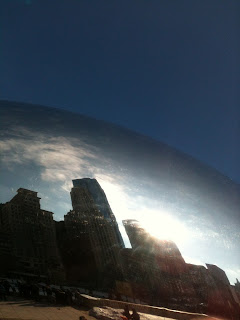Answers to an upcoming interview with a vinyl-specific music reviewer, conducted via Skype.
1) How did the initial idea to put out the LP come about?
Jane Boxall: "I wanted to put the album out in multiple formats -- CD, digital download and vinyl. The vinyl format is something I like on an aesthetic level, and also I feel that the "warmth" of LP sounds mirrors the warm tone of the solo marimba as an instrument. There's also a history of marimba records being released on vinyl -- this is an instrument that has been made in its current, concert-instrument form since 1910. All the early-to-mid century marimba recordings came out on vinyl, and I wanted to connect with that heritage in my 21st-century album release."
2) Does the album have a title yet and is there any info you can give me about the contents of it?
JB: "The working title of the album is simply Jane Boxall ~ Marimba From Zero to Eight Mallets, and the title tells you the contents. I've recorded a piece with zero mallets (in which I play the marimba with my hands), a piece with one mallet, and so on up through the numbers to an eight-mallet solo that closes the album. John Psathas' piece takes care of the four-mallet content."
3) For many of the people I've spoken to the economics of putting out an analogue recording was too much of a deterrent to bother. Why did this not apply to your planned LP?
JB: "I was lucky to have a successful
Kickstarter campaign that covers the initial cost of recording and releasing the album. Also, I'm making this a very limited edition run of vinyl to start with, so the numbers aren't as huge as they might otherwise be."
4) From what you've heard so far (if it's finished) what are your impressions of music on vinyl in comparison to hearing it on digital?
JB: "It's just... different. Both in terms of the sound and atmosphere of the vinyl by comparison to CD or a digital download. The sound of the vinyl obviously has that warm, analogue feel and slight "crackle"; psychologically I feel there's more of a "narrative" feel to vinyl. You can't set an LP to play in "shuffle" mode, and you have to turn the record over between sides. So there's an inbuilt order to the music on the album, and an inbuilt "intermission" -- both these factors make it feel, to me, somewhat like a live concert program (in which the musician has crafted a program order for the first and second halves). Because my "program" on this album is numerically sequential as I increase the number of mallets, I like this aspect of vinyl. I also think that tactile media -- whether vinyl or a CD -- makes a connection between the performer and the listener. The marimba is an acoustic instrument, and the physical space in which it's recorded has a really significant effect on the sound produced. I feel that releasing the album on physical media in some way brings the listener into the space in which I recorded (in this case, an 18th-century church in rural Vermont), while bringing the recording itself into the listener's home, as part of their CD or vinyl collection they look at, touch and listen to (and, in the case of vinyl, probably curse every time they move house -- I have lugged a lot of vinyl crates around the country!) I do think the convenience and reach of digital-download media is great for musicians in the 21st-century -- people from Auckland to Alabama will be able to download my album instantly -- but I also think the growth of non-tactile media has an isolating effect. Vinyl, in particular, maintains the real-world, physical connection between musicians and listeners.
5) Have you had an opportunity to hear a lot of classical music on vinyl? If you had a chance to hear a classical music recording/s on vinyl which would it be?
JB: "If at all possible, I like to hear my classical music live. That said, I live in a rural state so I listen to classical music on both vinyl and CD. One of my favourite vinyl albums is Vida Chenoweth's LP Classic Marimbist, released by Epic in 1962. This album reassigns music by Bach and Telemann to the marimba, but it's incredibly important in the history of the instrument for also including original pieces written specifically for marimba, by Musser, Fissinger and Goodrich. Chenoweth was the first marimbist to play programs of solo music composed specifically for the marimba. Composers only started writing for the marimba as a classical solo instrument in the 1940s and 1950s, so she really was a pioneer and her LP is a slice of history.
6) Do you know of any other classical music composers or musicians recording on vinyl?
JB: "Not off the top of my head. Nancy Van de Vate puts out a great series of contemporary-classical CD recordings on her Vienna Modern Masters label, now going through Naxos. I'd love to see some of these recordings anthologized on vinyl! However, I see lots of rock bands opting for vinyl these days. I think it's a way to make a release more "special" and collectible."


































